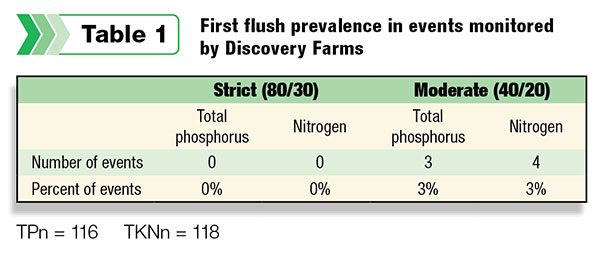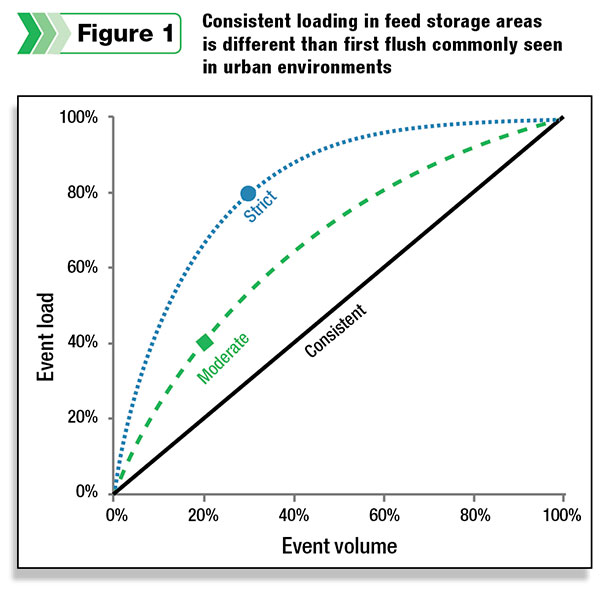In response to requests from both the farming community and the Wisconsin Department of Natural Resources, the University of Wisconsin Discovery Farms program monitored feed storage capture systems on working farms to determine their effectiveness.
It is important that these systems collect what is hot but don’t collect more liquid than is necessary. This collection balance is difficult to achieve but it is necessary for both water quality and a farmer’s bottom line.
Current designs are based on urban phenomenon
When something had to be done to ensure nutrient-rich water from feed storage areas did not enter waterways, regulators used the best available information. There is extensive research around how urban environments function. Since this body of literature exists, and both urban areas and feed storage areas are impervious, the urban literature was used as the basis for the standards.
Current feed storage capture systems are designed based on a phenomenon seen in urban environments called “first flush.” A first flush is the initial portion of an event having the greatest impact on water resources due to its proportionally high amount of contaminants.
Unfortunately, at the time standards were established, there was no on-farm research to confirm whether or not a first flush occurs in feed storage environments. The leachate study is filling the on-farm data gap.
The UW Discovery Farms program, part of UW Extension, works with farmers to quantify agriculture’s water quality impacts. Discovery Farms monitored water quality entering collection systems and vegetated treatment areas from bunker silage storage areas on three Wisconsin dairies. Monitoring has ended, and the program is now analyzing the data.
Calculating first flush
The first major step in determining if current feed storage systems are effective is to understand whether or not monitored events have a first flush. A common method for calculating first flush is to use mass-volume curves where the percent of an event’s load (mass) is compared to the percent of an event’s volume.
A first flush occurs when the percentage of the total amount of constituents (load) from an event leaving the concrete pad is greater than the percentage of the total liquid (volume) that has run off at a specified point in an event.
First flush is rare in feed storage areas
Current systems capture the initial liquid produced based on the assumption that first flush exists. According to one of the most common definitions, a first flush occurs when 80 percent of an event’s load occurs within the first 30 percent of the event’s volume. However, of the roughly 120 events monitored by Discovery Farms, not a single one had a first flush using the 80-30 definition (Table 1).
 Even when using a more moderate definition of first flush, it occurred in less than 4 percent of monitored events. First flush, as defined by both the strict and moderate definitions, is extremely rare in feed storage areas.
Even when using a more moderate definition of first flush, it occurred in less than 4 percent of monitored events. First flush, as defined by both the strict and moderate definitions, is extremely rare in feed storage areas.
Feed storage area data sheds light on need for changes
We are seeing that loading is consistent throughout an event instead of being greatest at the beginning of an event, like it commonly is in urban environments. When graphed, the majority of the data collected was close to linear, suggesting consistent loading, and did not fall close to moderate or strict forms of first flush (Figure 1).
 Loading in feed storage environments is relatively consistent because any time water interacts with feed, it picks up nutrients and organic acids produced as part of the ensiling process. Although the load of constituents is consistent, periods of low flow are commonly greatest at the end of events. Thus, concentration – a combination of flow and load – is often high at the end of events, when current systems are not designed to collect liquid.
Loading in feed storage environments is relatively consistent because any time water interacts with feed, it picks up nutrients and organic acids produced as part of the ensiling process. Although the load of constituents is consistent, periods of low flow are commonly greatest at the end of events. Thus, concentration – a combination of flow and load – is often high at the end of events, when current systems are not designed to collect liquid.
These results highlight the importance of on-farm data and the need for standards that result in effective capture systems. UW Discovery Farms is working alongside system designers to create design alternatives that can function better for both water quality and farm economics.
We have worked with farmers for more than 12 years and know it is important that any solution is practical and feasible for farmers. The hope is that future design criteria will offer more options to help fit farmers’ specific needs while at the same time collecting more of what is hot. PD
Callie Herron is the Discovery Farms outreach specialist and Aaron Wunderlin is a Discovery Farms senior research specialist with the University of Wisconsin. To learn more about UW Discovery Farms’ leachate project, visit their website or contact Aaron Wunderlin.
PHOTO: Aaron Wunderlin, University of Wisconsin Discovery Farms senior research specialist, collects leachate samples from one of three dairy farm sites. Photo provided by UW Discovery Farms.





